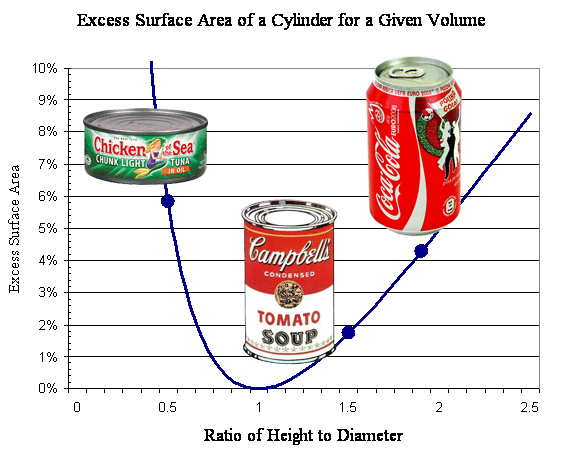|
Copyright ©2008 by Paul Niquette. All rights reserved. Science has a modern definition -- "reverse engineering nature." -- Paul Niquette Sophisticated:
The
Magazine 1996
|
|
Copyright ©2008 by Paul Niquette. All rights reserved. Science has a modern definition -- "reverse engineering nature." -- Paul Niquette Sophisticated:
The
Magazine 1996
|
A cylindrical container with diameter D inches and height H inches requires a surface area... [1] A
= To facilitate the analysis, let us define a dimensionless ratio... [3] C =
H / D, so that substitution of H
= C D into [2]... Substituting [5] into [1], produces the following relationship: [6] A
= Observe that the size factor FSIZE imposes
the Square-Cube Law as follows:
Meanwhile, the shape factor FSHAPE plays
an independent role...
[10] d[(C
+ 1/2) C -2/3] / dC
= (1/3)(C -2/3 - C -5/3) =
0, which simplifies to...
That will not surprise sophisticated solvers who know that for any volume, a sphere has the smallest surface area. A tin-can with C = 1.0 mandates that H = D, which is about as close to a spherical shape as a cylinder can get. For maximizing volumetric efficiency, designers of internal combustion engines exploit H = D (stroke = bore) in what they called the "square cylinder," by which swept area and therefore heat-loss is minimized for a given displacement. Substituting [12] into [6], we obtain the minimum surface area for a cylindrical container required to accommodate a given volume... [13] AMINIMUM = Any value of C > 1.0 or C < 1.0 will require more than the minimum amount of material... [14] AEXCESS
= 
Cupboards and
refrigerators, boxes and box-cars, trailers and
trucks, cartons and crates, warehouses and shipping
containers -- all are rectangular in both
elevation and planform, none are themselves
cylindrical. Cylinders are indeed round pegs
in square holes. It is easy to show that every
can-in-a-box takes up 21.46% more volume than it
holds (1- Let a box enclose cylindrical containers (cans) having dimensions D and C D. Assume the cans are arranged in m by n rows. The internal surface area of the box to accommodate the cans would be given by... [15] ACANS = 2 D2 [C (m + n) + m n]. Of course, the box will require more material than that for structure and strength.
Try substituting these numbers into [15]. You will find the value of C that requires the least amount of cardboard is 1.9. Coincidence?
Epilog The following explanation was received in July 2008 from Myles Buckley: The 4% excess material is a function of burst strength vs crush load resistance, according to Duncan Hosford in "The Aluminum Beverage Can" in the September 1994 edition of Scientific American Magazine. Hosford described the efforts of Coca Cola and Pepsi Co. to minimize the need for aluminium, which imposes by far the single highest cost of production for their canned soft drinks. The pop-can is very thin on its side-wall. More aluminum by mass is found in the top ridges (not to cut the drinker's lips) and more again at the base. The can has three "pieces." A slug of aluminum is extruded to form the base and sides; a disk forms the top (including the "button" that holds the pull tab); the pull-tab itself is the third piece. Ten years
after the publication of Tin-Can
Mystery, in July 2018, the link to a
brilliantly produced video entitled The
Ingenious Design of the Aluminum Beverage Can
was received from long-time friend Norm Bryga,
who neglected to warn me that one might become
tempted to devote many hours indeed studying the
animated presentations of Engineerguy.
-- PN
|
![]()
|
|
|
|
|